 |
|||||
 |
 |
 |
 |
 |
 |
 |
Plant of the Month: Echinacea |
||||
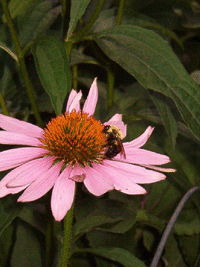 It’s been so mild in the city throughout November that the earth is still soft enough to dig up roots and prepare them into remedies for the winter months ahead. As the cold winds start to blow, we’d all like to avoid catching that cold or flu bug that may be drifting by. One of the best herbal allies for our immune systems is Echinacea and the purpurea species grows abundantly in our zone 5 climate! The bright pink flowers are now dark, dry and bursting with seeds, but the roots are still succulent and vibrant, full of medicine to keep you and your loved ones healthy throughout the year. If your Echinacea patch is at least three years old, preferably five, you may want to consider digging up a few roots and making your own tincture. Scrub your fresh roots gently with a stiff brush to remove as much dirt as possible. Then put them in a mason jar and pour vodka to the top of the jar (for best results use a vodka or other menstruum containing 50% alcohol). Store in a cool dark place for six weeks, giving the jar a shake whenever the spirit moves you to do so! Or follow these directions using dried root (ideally augustifolia) instead of the fresh and macerating it for at least six months instead of six weeks. Strain the vodka, which is now a tincture, through a fine linen cloth or unbleached coffee filter and bottle it. If the ground is already frozen, and time is too short to make your own, there are many excellent products at your local health food store. 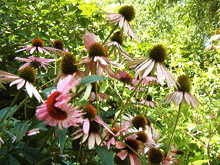 Native Americans used this indigenous plant long ago as an antidote to snake bites and to heal burns, toothache and infected wounds. Matthew Wood considers it a “heritage gift” for which I’m most grateful! At the beginning of the 20th century it was one of the most prescribed medicinal herbs. Now with more germs showing increased resistance to antibiotics, Echinacea is making a huge come-back. In recent years over 200 scientific studies have been published, some showing that Echinacea enhances the immune system in a variety of ways while others disprove the efficacy of Echinacea’s ability to prevent a cold (although most studies do agree to less severity and duration!). Many studies haven’t been designed well enough to find out whether it works consistently or not, and preparation and dosage also play significant roles. I know if I take Echinacea tincture at the very first sign of a cold I can usually keep it away! The fact that it’s one of the biggest selling herbal products on the market also makes me believe it’s working for many individuals! 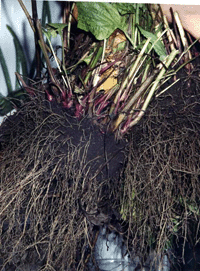 At the International Herb Symposium in 2000, Daniel Gagnon presented convincing evidence supporting Echinacea’s ability to act as both an immune system tonic and stimulant. The list of Echinacea’s amazing abilities is a long one:
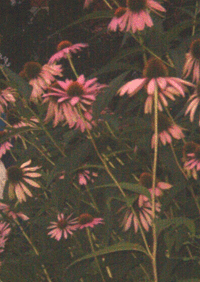 Echinacea is loaded with antioxidants including carotenes, flavonoids, quercetin, selenium, limonene, pinenes and several minerals which are all health enhancers. According to Matthew Wood, Echinacea acts most strongly on the lymphatic system and blood. Besides helping to diminish colds, Echinacea has been used for years to treat many infections including those of the urinary tract, respiratory system, skin, sinus and prostate. I would take it to counter the possibility of SARS, anthrax or malaria. Echinacea works best taken when you need it. It’s not considered to be safe when used as long-term preventative therapy. My favourite Echinacea preparation is the root tincture, which is safe for practically everyone. In Germany, where children, pregnant and breast-feeding women are among the millions of people to routinely take Echinacea, there have never been any reported side effects or toxicity. If you suffer from hay fever the root tinctures won’t provoke allergic reactions (whereby the above ground plant might ). Individuals who have allergies to the Asteraceae family (ragweed, chamomile, daisy, chrysanthemum) should seek out preparations made with the root. The best way to take the tincture is to mix it (1 drop per kg. body weight) with water in a shot glass, then gargle it and swish it around your mouth for at least thirty seconds before swallowing. For acute conditions take it every hour or two and dose less frequently as you feel better. Don’t worry about the tingling tongue! 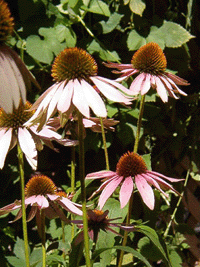 You can also use Echinacea topically. I keep a spray-bottle of tincture in my garden shed and first aid kit which I squirt on ant, spider or mosquito bites. It cools off the sting while acting as an antibacterial-antiviral wash. (think West Nile virus!) Alcohol preparations made with the leaves or flowers also contain medicinal properties in different concentrations, which some find is exactly what they need and others find inferior to the root. Many also enjoy sipping an infusion of the dried flowers, leaves or decoctions of the dried roots. Unfortunately capsules, chewable tablets, pills and candies have little effect and are best avoided. Caution: There has been some speculation that autoimmune diseases should be cautious taking Echinacea although there is no data to support this claim. Consult with your health care practitioner.
| |||||
 | |||||
|
Over the years I have been blessed with many inspirational teachers. I thank them for sharing their wisdom through their lectures, workshops, websites and books. For more information about Echinacea and many other herbs, enjoy these insightful and informative resources. | |||||
| Opening our Wild Hearts to the Healing Herbs by Gail Faith Edwards |
(Ash Tree Publishing, 2000) Click for website | ||||
“Differentiation of Seven Immune System Herbs” |
For more information on future herbal conferences and events organized by Sage Mountain visit www.sagemountain.com | ||||
| Herbal Therapy & Supplements: A Scientific & Traditional Approach by Merrily Kuhn & David Winston |
(Lippincott Williams & Wilkins 2001) www.herbaltherapeutics.net |
||||
| Healing Wise ...Protect Yourself -- it's the Flu Season! by Susun S. Weed |
Weed Wanderings e-zine articles Click for the article |
||||
| Herbal Medicine Chest …Protect yourself from SARS! by Susun S. Weed |
Weed Wanderings e-zine articles Click for the article |
||||
| The Book of Herbal Wisdom: Using Plants as Medicine! by Matthew Wood |
(North Atlanta Books, 1997) www.matthewwoodherbs.com | ||||

|
|||||
 ©2025 Monica Giacomin ©2025 Monica Giacomin |
|||||
